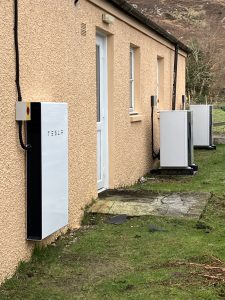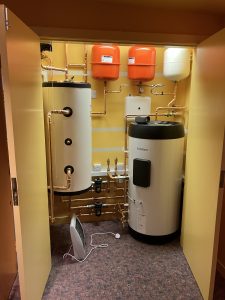Location: Achmore, Highlands
Technology: Solar photovoltaic (PV) panels, energy storage, air source heat pump
CARES funding: £37,810.32
Date installed: February 2025
Background
The Achmore and Stromeferry Village Hall is a hub for community events, groups and classes. The hall is in Achmore and is managed by the Achmore Community Hall Association.
The Achmore Community Hall Association wanted to reduce its dependency on oil after experiencing rising costs and a limited choice of suppliers due to the hall’s remote location. It had thought about installing renewable technologies before, but couldn’t go ahead with the project as there wasn’t any funding available.
However, it decided to look into this idea again after learning that Breakish Village Hall got funding from the Scottish Government’s Community and Renewable Energy Scheme (CARES) to install solar PV panels and battery storage.
Project aims and objectives
The Achmore Community Hall Association wanted to replace the hall’s heating system with an air source heat pump and to install solar PV panels, along with battery storage. The solar panels would give the Achmore Community Hall Association the ability to generate its own energy to help towards the running costs of the air source heat pump. A committee was set up to manage the project.
The Achmore Community Hall Association spoke to other village halls that had carried out similar work to learn about their experiences. It also asked for a business energy assessment from Business Energy Scotland, which highlighted areas of heat loss in the hall and the potential funding available. Although the Achmore Community Hall Association couldn’t afford to do all the work recommended in the report to reduce heat loss, it did replace two of the hall’s doors.
Outcomes and achievements

The Achmore Community Hall Association applied to CARES and got a capital grant of £37,810.32, which covered 80% of the project’s cost. The other 20% was covered by the Sustainable Development Fund from SSE Renewables.
The air source heat pump was installed in January 2025, followed by the installation of solar panels and a storage battery in February 2025. The Achmore Community Hall Association note that the support from its CARES local development officer, from the application phase to installation, made a big difference to the project’s success.
The Achmore Community Hall Association shared that getting used to the new system is a work in progress. It’s found that more forward planning is needed to meet the heating needs for the different types of activities the hall is used for, which range from Cub Scouts to T’ai Chi sessions. This is important as the new hydronic heaters can take up to an hour to switch on.
As the project has only recently been completed, the Achmore Community Hall Association doesn’t yet know if it has made any financial savings. However, a spokesperson has shared, “All in all, it has been a steep learning curve for the committee, but we are all glad to have moved away from oil and feel incredibly lucky to have been given such a huge grant to complete it. It feels that we have kept the charm and character of the hall but have now brought it into the 21st century!”.

Lessons learned
The Achmore Community Hall Association shared that everyone in the community was happy to contribute to discussions, but one person did the project research and filled in the application form. This was because Achmore is a small community of around 129 people, so there was limited resource and help available. This was a large commitment for one person, and looking back, the Achmore Community Hall Association would have formed a subgroup of two to three people to help.
Another lesson was to be ready to talk with people who don’t agree with the project. There were four people in the community who felt that the project shouldn’t go ahead until the old heating system stopped working. A key takeaway is to have a person who understands the renewable technologies at community meetings, to reassure community members that have questions or concerns about the project.
Published August 2025.